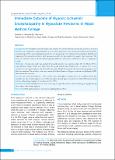Please use this identifier to cite or link to this item:
https://hdl.handle.net/20.500.14356/1696Full metadata record
| DC Field | Value | Language |
|---|---|---|
| dc.contributor.author | Shrestha, S | - |
| dc.contributor.author | Shrestha, G S | - |
| dc.contributor.author | Sharma, A | - |
| dc.date.accessioned | 2023-05-18T10:52:17Z | - |
| dc.date.available | 2023-05-18T10:52:17Z | - |
| dc.date.issued | 2016 | - |
| dc.identifier.citation | ShresthaS., ShresthaG. S., & SharmaA. (2016). Immediate Outcome of Hypoxic Ischaemic Encephalopathy in Hypoxiate Newborns in Nepal Medical College. Journal of Nepal Health Research Council, 14(2). https://doi.org/10.33314/jnhrc.v14i2.792 | en_US |
| dc.identifier.issn | Print ISSN: 1727-5482; Online ISSN: 1999-6217 | - |
| dc.identifier.uri | http://103.69.126.140:8080/handle/20.500.14356/1696 | - |
| dc.description | Original Article | en_US |
| dc.description.abstract | Abstract Background: Birth asphyxia is the fifth major cause of under-five child deaths after pneumonia, diarrhoea, neonatal infections and complications of preterm birth. It is one of the important causes of neonatal mortality and morbidity accounting up to 30% of neonatal death in Nepal. It is also an important cause of long-term neurological disability and impairment. The mortality rate due to birth asphyxia is considered a good guide to the quality of perinatal care. This study was conducted to assess the rate of birth asphyxia, risk factors and outcome of the babies who were asphyxiated at birth. Methods: : A prospective study was conducted during the period of one year from April 2013 to March 2014 in Nepal Medical College. All the term babies born during the period with APGAR score at 5 minutes of < 7 were considered to have birth asphyxia and included in the study. Details of maternal risk factors during pregnancy and labor were analyzed. The newborn babies were assessed for clinical features of hypoxic ischemic encephalopathy (HIE) and its immediate outcome. Results: Out of 2226 live births, 47 (15.9%) newborns had birth asphyxia with the rate of 21.1/1000 live births. The mortality rate due to birth asphyxia was 4.25%. Meconium stained liquor was present in 31(65.96%) cases during delivery and prolonged rupture of membrane in 7(14.89%). Conclusions: Early identification and close monitoring of high-risk mothers with maintaining partograph during labor help to reduce birth asphyxia. Keywords: Birth asphyxia; hypoxic ischaemic enecphalopathy; newborn. | en_US |
| dc.language.iso | en | en_US |
| dc.publisher | Nepal Health Research Council | en_US |
| dc.relation.ispartofseries | May-Aug, 2016;792 | - |
| dc.subject | Birth asphyxia | en_US |
| dc.subject | Hypoxic ischaemic enecphalopathy | en_US |
| dc.subject | Newborn | en_US |
| dc.title | Immediate Outcome of Hypoxic Ischaemic Encephalopathy in Hypoxiate Newborns in Nepal Medical College | en_US |
| dc.type | Journal Article | en_US |
| local.journal.category | Original Article | - |
| Appears in Collections: | Vol. 14 No. 2 Issue 33 May-Aug 2016 | |
Files in This Item:
| File | Description | Size | Format | |
|---|---|---|---|---|
| 792-Article Text-1469-2-10-20170528.pdf | Fulltext Download | 196.53 kB | Adobe PDF |  View/Open |
Items in DSpace are protected by copyright, with all rights reserved, unless otherwise indicated.
